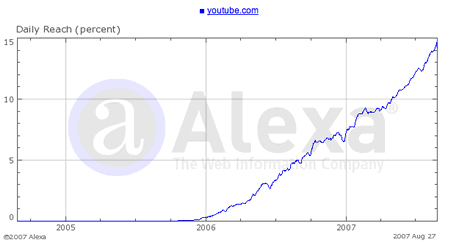YouTube, Lazy Sunday, and Elephant Math
Read an amazing statistic today about YouTube.
It involves Lazy Sunday, the hilarious Saturday Night Live skit performed by Andy Samberg & Chris Parnell which exploded on the Web in January 2006, generating over 5 million views and generally signaled the power of the viral growth of video. (read more about Lazy Sunday here)
The stat: in the weeks following Lazy Sunday, YouTube’s traffic grew 83%. 1

At the time YouTube was growing, but Lazy Sunday was, in today’s vernacular, the “tipping point” which shot YouTube to stratospheric mind share. After Lazy Sunday, there was no question as to who the #1 video site in the world was. (YouTube was purchased in November 2006 for 1.65 billion)
This tipping point is even more startling when you look at the growth curve of YouTube…and notice that it started really growing in the December/January 2006 time frame. Wow.
Read an amazing statistic today about YouTube.
It involves Lazy Sunday, the hilarious Saturday Night Live skit performed by Andy Samberg & Chris Parnell which exploded on the Web in January 2006, generating over 5 million views and generally signaled the power of the viral growth of video. (read more about Lazy Sunday here)
The stat: in the weeks following Lazy Sunday, YouTube’s traffic grew 83%. 1

At the time YouTube was growing, but Lazy Sunday was, in today’s vernacular, the “tipping point” which shot YouTube to stratospheric mind share. After Lazy Sunday, there was no question as to who the #1 video site in the world was. (YouTube was purchased in November 2006 for 1.65 billion)
This tipping point is even more startling when you look at the growth curve of YouTube…and notice that it started really growing in the December/January 2006 time frame. Wow.

What is Viral Growth?
The story here is viral growth. We all have a sense as to what viral growth is, but do we really know how to make it happen? Let’s imagine that we were starting another YouTube-like service…how would we go about doing it?
In the case of YouTube and Lazy Sunday, there seems to be two pieces to the puzzle.
The first piece is great content. The quality of Lazy Sunday is what drove the viral growth of YouTube at that time. It’s just a great, funny, unique video that you can’t find anywhere else. It’s got hooks into several different audiences, as it references various pop-culture phenomena (Chronicles of Narnia, Google Maps, The Notebook, Ghost, getting high). This type of content drives real demand…people like it and want to talk about it.
But people also needed an easy way to share it. Interestingly, in addition to YouTube Lazy Sunday was also put on iTunes at the time. iTunes, of course, is the world’s leading online music distribution service. But the growth and spread of Lazy Sunday didn’t happen through iTunes, it happened through YouTube. One obvious hurdle is that iTunes charges for content. Another crucial difference is that iTunes sharing features are to YouTube like a Gremlin is to a Tesla.
There is where design comes in. YouTube has some great sharing features. They have fantastic Flash player that works everywhere as well as super-easy cut-and-paste code that bloggers can easily share with. It’s practically a no-brainer to share video with YouTube. This brings to mind the #1 rule of interface design: the easiest action gets done most.
So it’s a combination of great content and great design that drove the amazing growth on YouTube. The design of the site was crucial when the demand finally hit. Without the demand, though, the design doesn’t do much.
In many cases, however, the majority of energy on viral social web apps is placed at launch time. So much energy and focus is spent that it is easy to overlook the tipping points that have catapulted others to glory. YouTube would definitely have been successful on some level, but without Lazy Sunday they wouldn’t have had such explosive growth.
Elephant Math
Seth Godin calls our expectations of viral growth Elephant Math, referring to some calculations Darwin did on elephant breeding. The idea is that when we think of viral, we think of unrestrained, exponential growth. We imagine 1 person telling 10 others, and then those 10 each telling 10 others, and so on.
Seth says:
“It’s pretty clear it doesn’t work that way. Perfect viral growth, even slow viral growth, rarely happens. If it did, we’d have an elephant problem.
The same thing happens with your idea. If one person told four and the cycle repeated itself for a few generations, everyone would know about it. But they don’t.”
The reality is far different, as Seth points out. Viral growth isn’t exponential, it looks more like big spikes, like what Lazy Sunday did for YouTube.
(Source of 83% statistic: New York Magazine story on Andy Samberg – stat is at bottom of page 3)